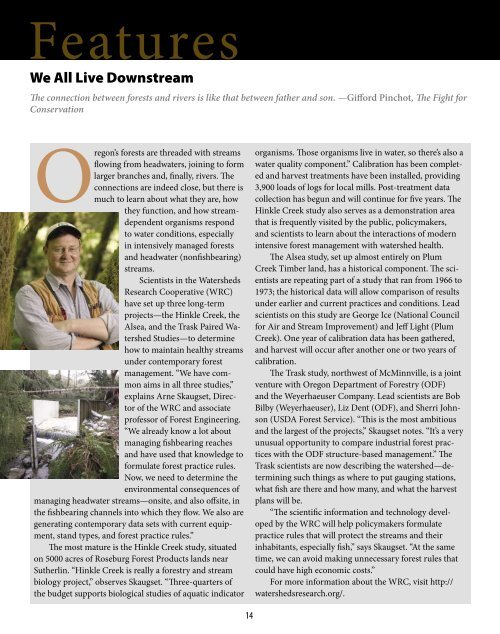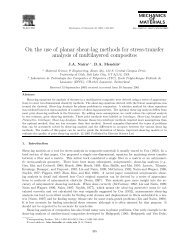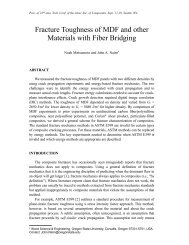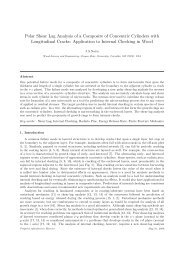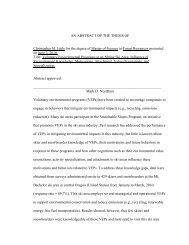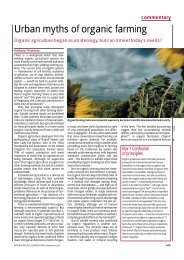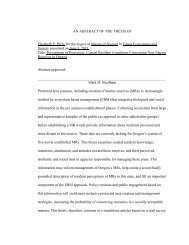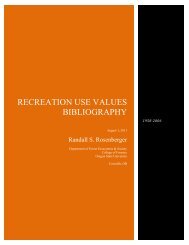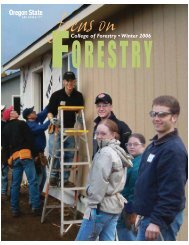College of Forestry - Oregon State University
College of Forestry - Oregon State University
College of Forestry - Oregon State University
You also want an ePaper? Increase the reach of your titles
YUMPU automatically turns print PDFs into web optimized ePapers that Google loves.
Features<br />
We All Live Downstream<br />
The connection between forests and rivers is like that between father and son. —Gifford Pinchot, The Fight for<br />
Conservation<br />
<strong>Oregon</strong>’s forests are threaded with streams<br />
flowing from headwaters, joining to form<br />
larger branches and, finally, rivers. The<br />
connections are indeed close, but there is<br />
much to learn about what they are, how<br />
they function, and how streamdependent<br />
organisms respond<br />
to water conditions, especially<br />
in intensively managed forests<br />
and headwater (nonfishbearing)<br />
streams.<br />
Scientists in the Watersheds<br />
Research Cooperative (WRC)<br />
have set up three long-term<br />
projects—the Hinkle Creek, the<br />
Alsea, and the Trask Paired Watershed<br />
Studies—to determine<br />
how to maintain healthy streams<br />
under contemporary forest<br />
management. “We have common<br />
aims in all three studies,”<br />
explains Arne Skaugset, Director<br />
<strong>of</strong> the WRC and associate<br />
pr<strong>of</strong>essor <strong>of</strong> Forest Engineering.<br />
“We already know a lot about<br />
managing fishbearing reaches<br />
and have used that knowledge to<br />
formulate forest practice rules.<br />
Now, we need to determine the<br />
environmental consequences <strong>of</strong><br />
managing headwater streams—onsite, and also <strong>of</strong>fsite, in<br />
the fishbearing channels into which they flow. We also are<br />
generating contemporary data sets with current equipment,<br />
stand types, and forest practice rules.”<br />
The most mature is the Hinkle Creek study, situated<br />
on 5000 acres <strong>of</strong> Roseburg Forest Products lands near<br />
Sutherlin. “Hinkle Creek is really a forestry and stream<br />
biology project,” observes Skaugset. “Three-quarters <strong>of</strong><br />
the budget supports biological studies <strong>of</strong> aquatic indicator<br />
organisms. Those organisms live in water, so there’s also a<br />
water quality component.” Calibration has been completed<br />
and harvest treatments have been installed, providing<br />
3,900 loads <strong>of</strong> logs for local mills. Post-treatment data<br />
collection has begun and will continue for five years. The<br />
Hinkle Creek study also serves as a demonstration area<br />
that is frequently visited by the public, policymakers,<br />
and scientists to learn about the interactions <strong>of</strong> modern<br />
intensive forest management with watershed health.<br />
The Alsea study, set up almost entirely on Plum<br />
Creek Timber land, has a historical component. The scientists<br />
are repeating part <strong>of</strong> a study that ran from 1966 to<br />
1973; the historical data will allow comparison <strong>of</strong> results<br />
under earlier and current practices and conditions. Lead<br />
scientists on this study are George Ice (National Council<br />
for Air and Stream Improvement) and Jeff Light (Plum<br />
Creek). One year <strong>of</strong> calibration data has been gathered,<br />
and harvest will occur after another one or two years <strong>of</strong><br />
calibration.<br />
The Trask study, northwest <strong>of</strong> McMinnville, is a joint<br />
venture with <strong>Oregon</strong> Department <strong>of</strong> <strong>Forestry</strong> (ODF)<br />
and the Weyerhaeuser Company. Lead scientists are Bob<br />
Bilby (Weyerhaeuser), Liz Dent (ODF), and Sherri Johnson<br />
(USDA Forest Service). “This is the most ambitious<br />
and the largest <strong>of</strong> the projects,” Skaugset notes. “It’s a very<br />
unusual opportunity to compare industrial forest practices<br />
with the ODF structure-based management.” The<br />
Trask scientists are now describing the watershed—determining<br />
such things as where to put gauging stations,<br />
what fish are there and how many, and what the harvest<br />
plans will be.<br />
“The scientific information and technology developed<br />
by the WRC will help policymakers formulate<br />
practice rules that will protect the streams and their<br />
inhabitants, especially fish,” says Skaugset. “At the same<br />
time, we can avoid making unnecessary forest rules that<br />
could have high economic costs.”<br />
For more information about the WRC, visit http://<br />
watershedsresearch.org/.<br />
14


